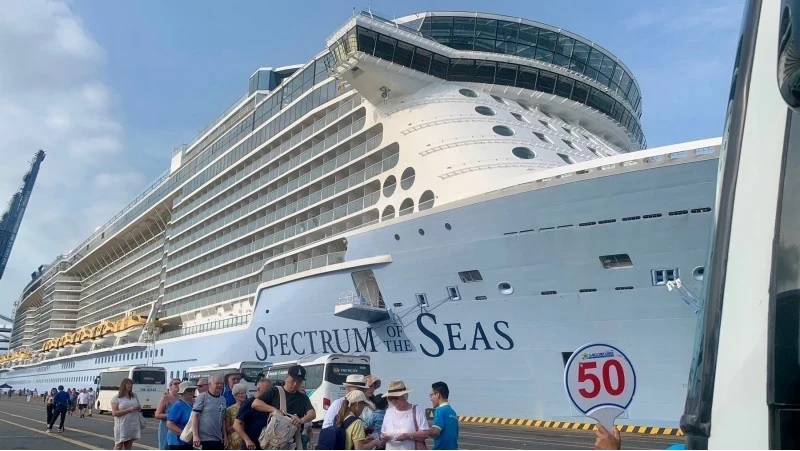Cruise tourism has existed for many years and is widely exploited in developed countries. According to the United Nations Tourism, cruise tourism has a revenue of 40% higher than tourism by air or road.

The international cruise ship Spectrum of the Seas, carrying more than 4,000 multinational tourists, docked at Tan Cang-Cai Mep Port in Phu My provincial-level town, Ba Ria - Vung Tau Province, on February 20, 2024.
Vietnam possesses a coastline of 3,260 kilometres with more than 4,000 large and small islands and reefs; and many beautiful bays and beaches, especially many deep-water ports, allowing large ships to anchor close to shore. Therefore, the country has many advantages in developing the cruise tourism market.
According to Wendy Yamazaki, a regional vice president for government relations (Asia) at the Royal Caribbean Group, Vietnam, along with Thailand and Singapore, are the three favourite destinations of cruise tourists in the world.
Cruise tourism has recently become one of the most vibrant development types, promoting the growth of the green economy and raising the brand of Vietnam's tourism in the international market.
According to a report by the Vietnam National Authority of Tourism (VNAT), in the first two months of 2024, Vietnam welcomed 90,700 international visitors by cruise ship, an increase of 7 times over the same period last year.
In February 2024, Phu Quoc (in Kien Giang Province) consecutively welcomed three large international cruise ships, including the 5-star French superyacht Le Jacques Cartier. Ha Long (in Quang Ninh Province) is also a notable destination, with an increasing number of travellers by cruise ship.
In January 2024 alone, 13 cruise ships docked at Ha Long International Cruise Port with nearly 20,000 European, American and Chinese tourists. It is expected that in 2024, there will be about 60 superyachts with 80,000 international tourists docking at Ha Long Port.
Meanwhile, Nha Trang City (in Khanh Hoa Province) has welcomed 15 cruise ships since the beginning of the year, including international super cruise ships, with a capacity of up to 4,000 passengers. Not far behind, Da Nang and Hue are expected to welcome 40-45 cruise ships in 2024. These numbers partly show the great potential of cruise tourism in Vietnam.
However, according to experts, cruise tourism has not been effectively exploited, and has not been commensurate with its potential. One of the reasons is that the exploitation of this "gold mine" faces many barriers from the infrastructure of tourist ports.
Vietnam doesn’t have a port specialising in sea tourism, only Ha Long has an international passenger wharf. The lack of ports specialising in sea tourism means that accompanying services are not consistent, and often have to give way to cargo ships. At some ports, tourists have to walk quite a distance to get to an area where they can get on the bus to go sightseeing, negatively affecting tourists’ experience.
In addition, the entry of ships and tourists takes a lot of time with many administrative procedures, causing difficulties for travel businesses. The number of businesses operating and capable of providing services for cruise tourists is not large; meanwhile, visa-related policies are not flexible, and the entry time by cruise is short.
Cruise ship visitors to Vietnam have high spending, so this tourism form needs to be identified as one of the strategic products. In other words, the tourism sector needs to have synchronous solutions to remove as many barriers and shortcomings as possible, creating a clear corridor for the development of cruise tourism.
Accordingly, it is crucial to focus on accelerating the investment and improvement of infrastructure at tourist ports; amending visa policies to be more open, and improving entry and exit procedures, towards minimising administrative procedures and avoiding inconvenience to customers. In addition, it is also essential to gradually establish a cruise tourism ecosystem to meet the increasing needs of the luxury market, prolong the length of stay and spending of tourists, and increase the competitiveness of destinations.
Minh Anh - Translated by NDO